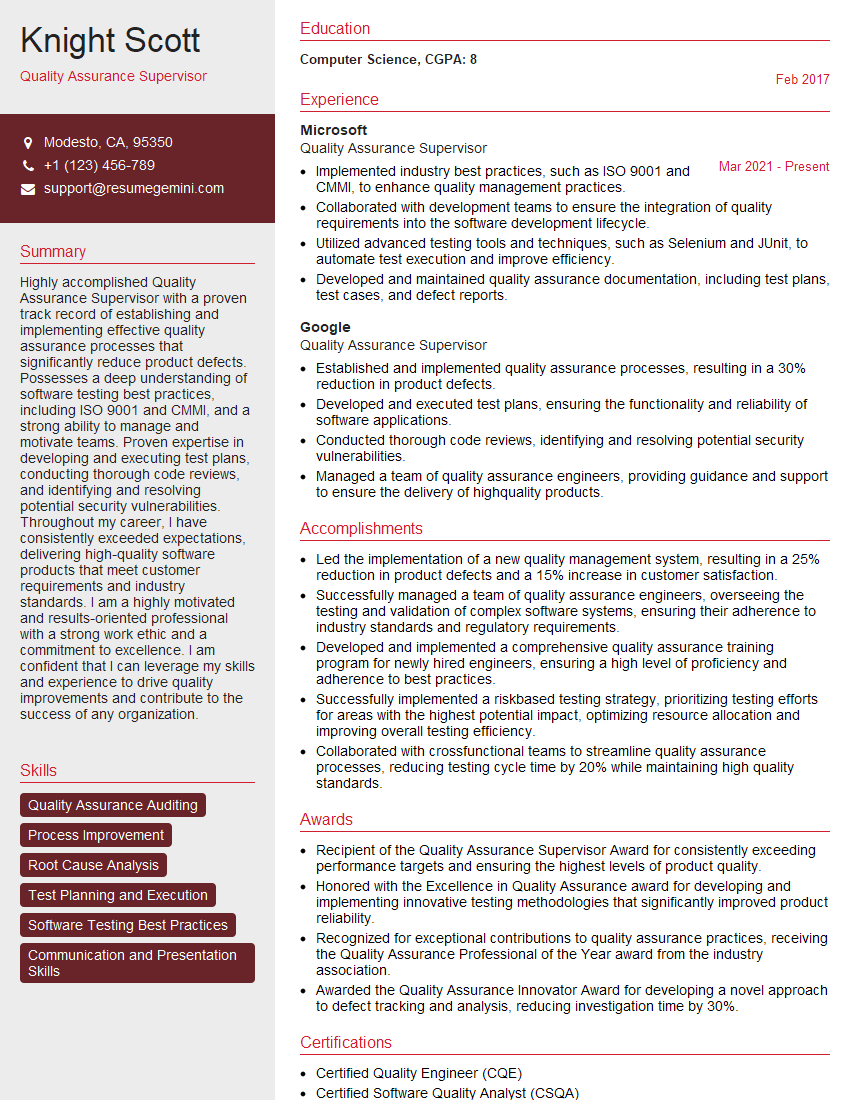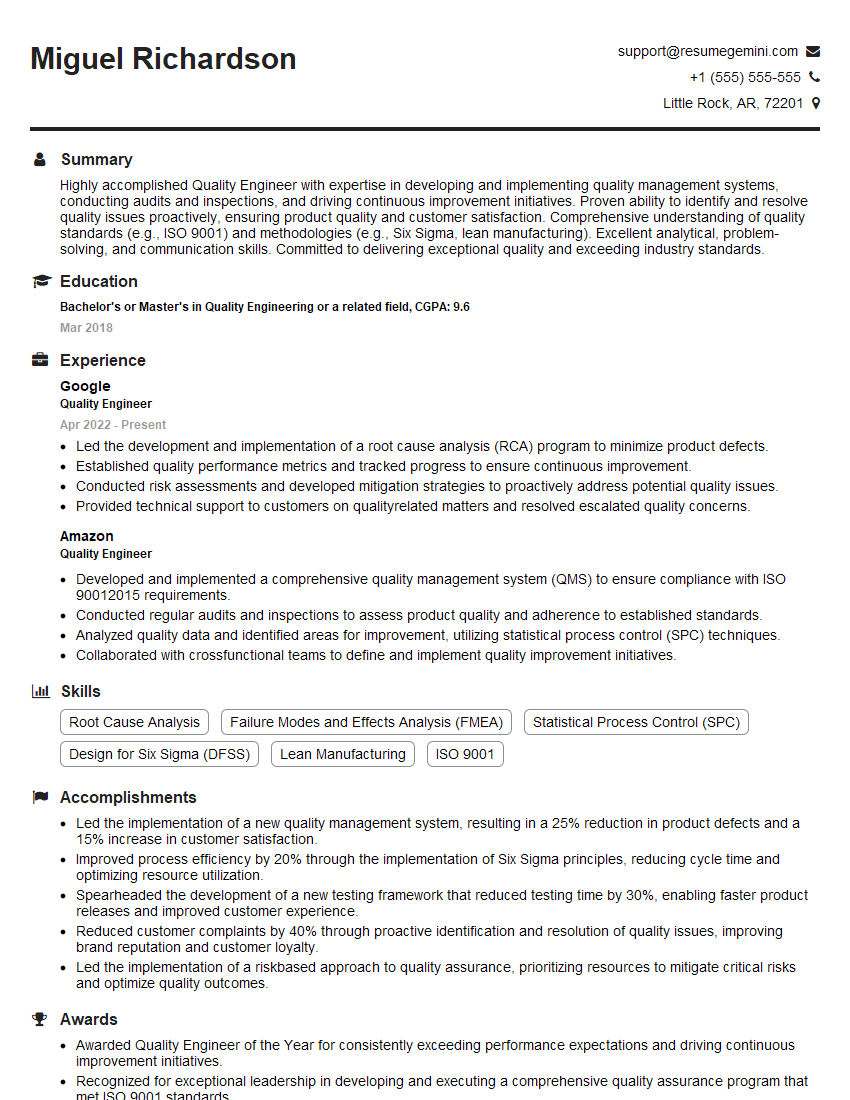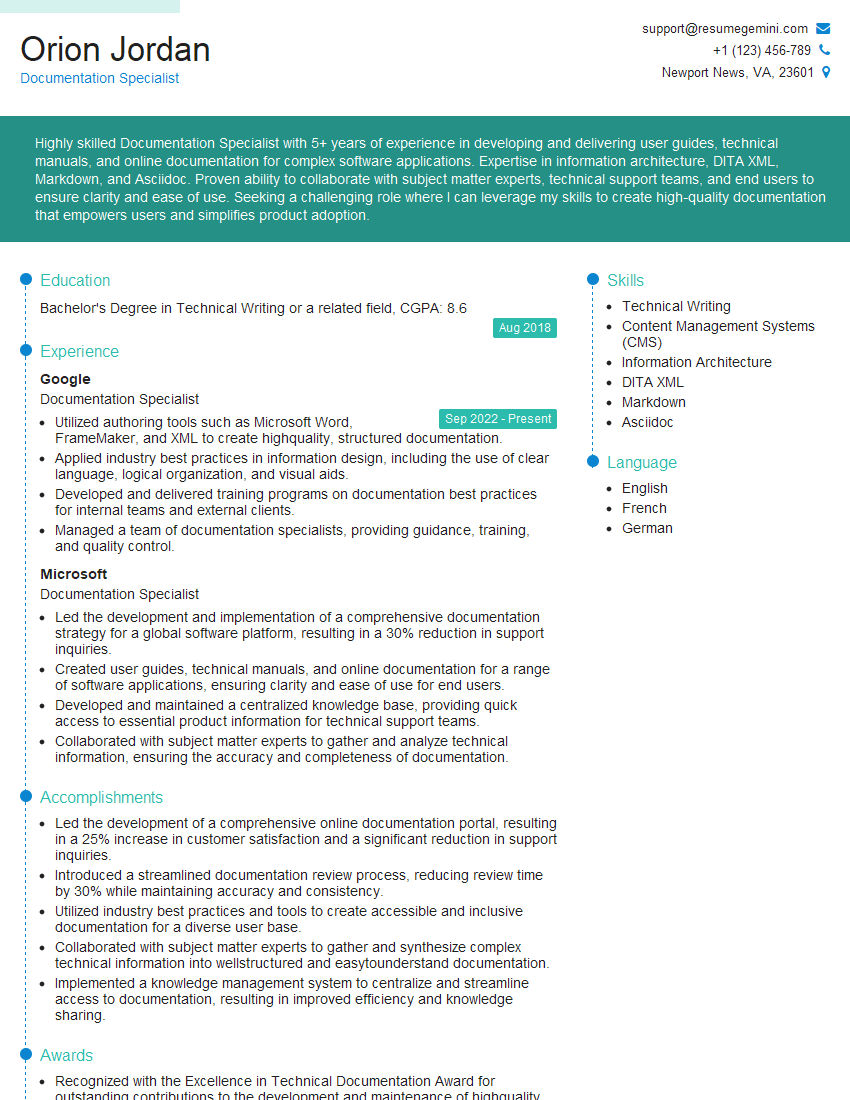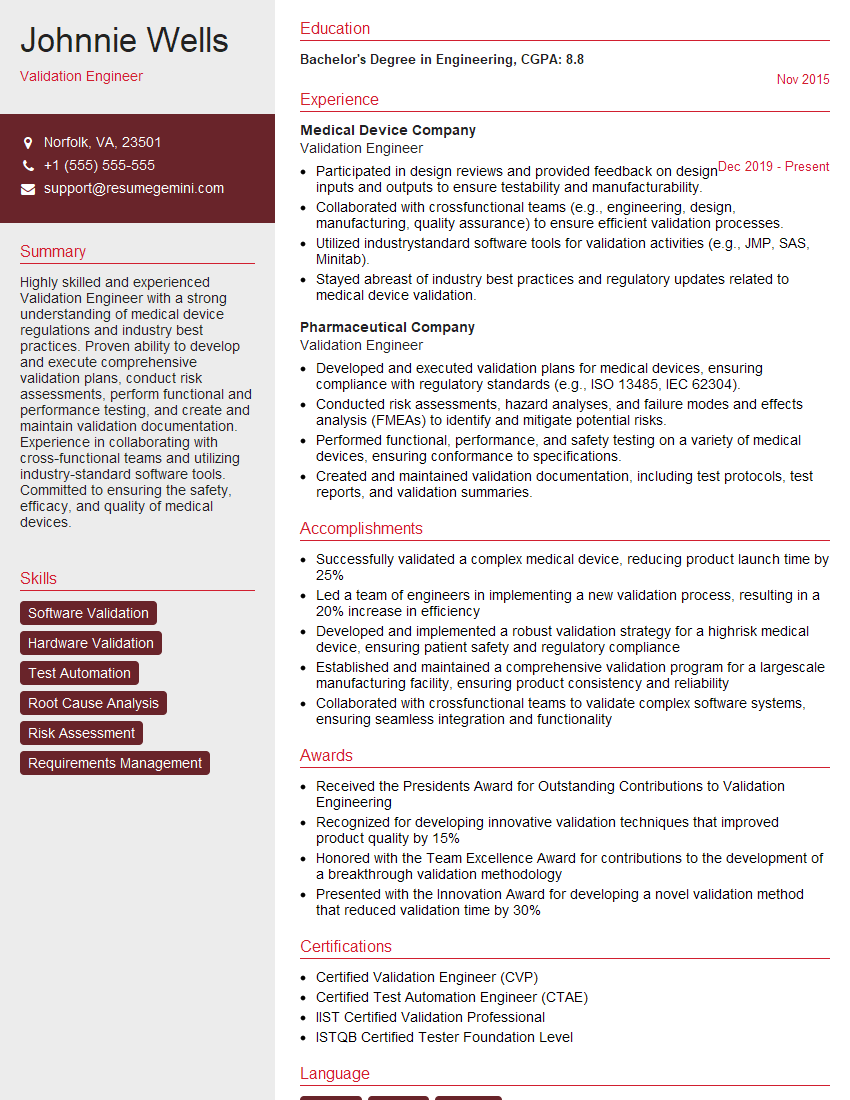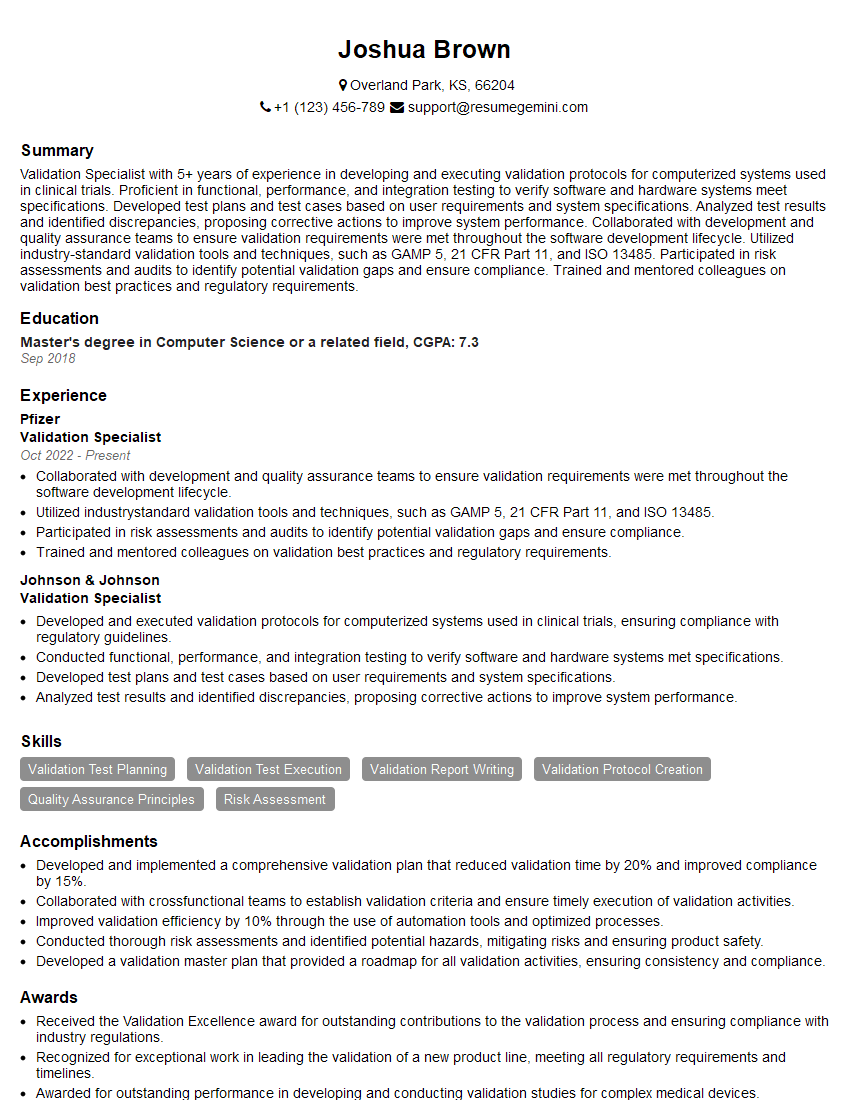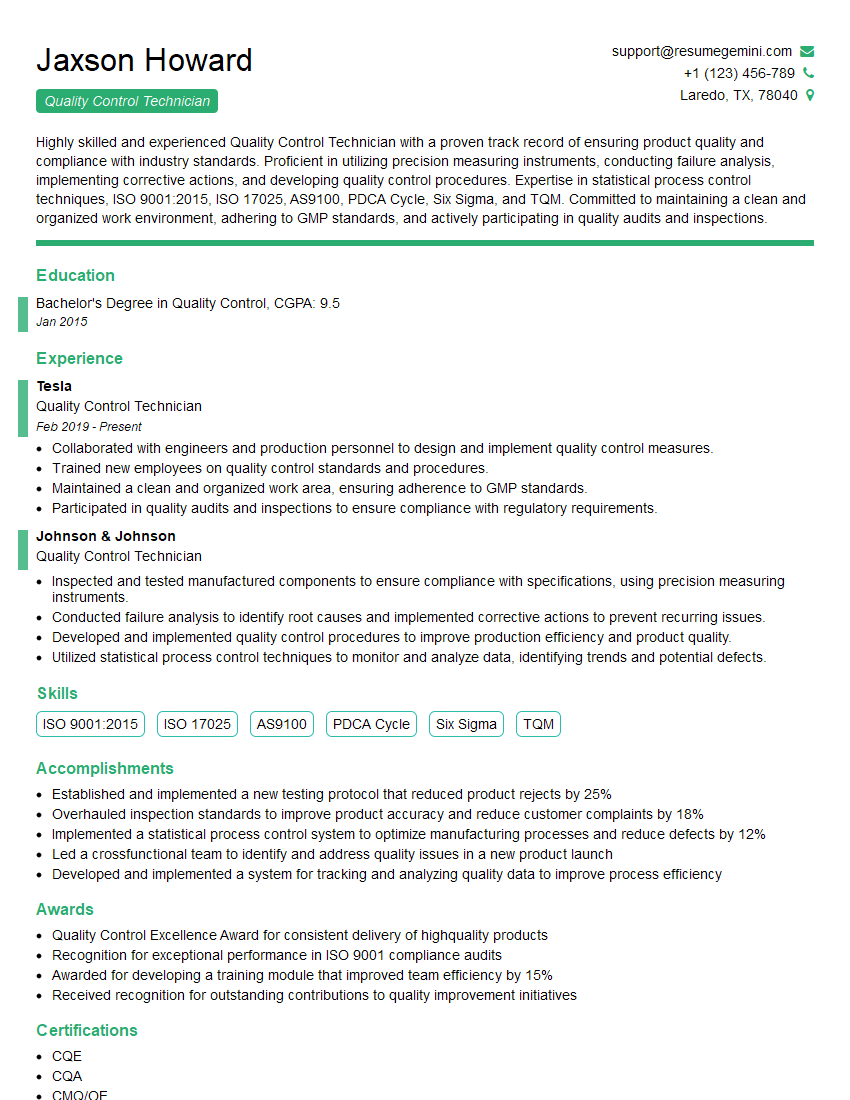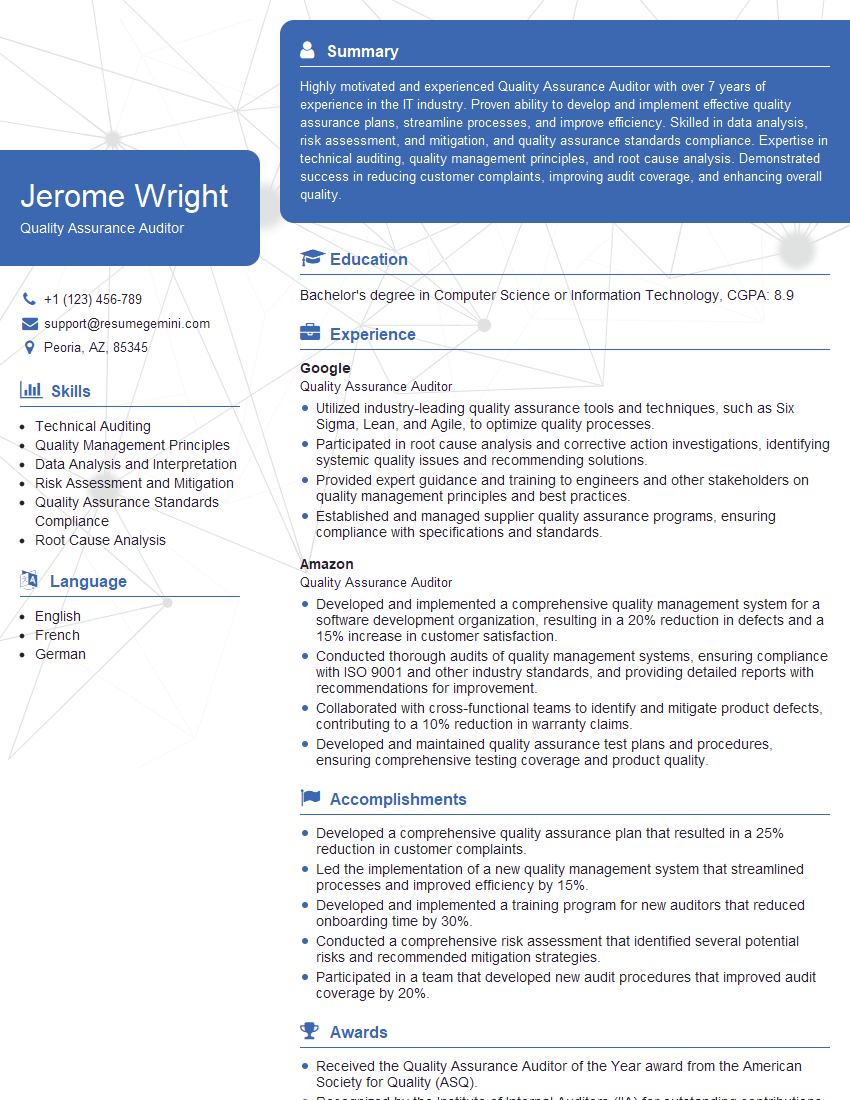Are you ready to stand out in your next interview? Understanding and preparing for CGMP and Quality Assurance Compliance interview questions is a game-changer. In this blog, we’ve compiled key questions and expert advice to help you showcase your skills with confidence and precision. Let’s get started on your journey to acing the interview.
Questions Asked in CGMP and Quality Assurance Compliance Interview
Q 1. Define CGMP and its significance in pharmaceutical manufacturing.
CGMP, or Current Good Manufacturing Practice, is a set of regulations enforced by regulatory agencies like the FDA (Food and Drug Administration) to ensure the consistent production of high-quality pharmaceutical products. It’s not just about making pills; it’s about guaranteeing those pills are safe, effective, and consistently meet the standards defined on the label. Think of it as a comprehensive quality system that covers every aspect of pharmaceutical manufacturing, from the initial sourcing of raw materials to the final packaging and distribution. Failure to comply with CGMP can lead to serious consequences, including product recalls, fines, and even criminal charges.
The significance of CGMP lies in its ability to protect public health. By implementing stringent quality control measures and documentation practices, CGMP minimizes the risks associated with manufacturing defects, contamination, and adulteration. This ultimately ensures patients receive safe and effective medications.
Q 2. Explain the difference between Quality Assurance and Quality Control.
While both Quality Assurance (QA) and Quality Control (QC) are crucial for ensuring product quality, they have distinct roles. Think of QA as the proactive, preventative arm, focused on preventing defects before they occur. QA sets the standards, develops the systems, and audits processes to ensure they are meeting those standards. QC, on the other hand, is the reactive, detective arm, focused on identifying defects *after* they happen. QC performs tests and analyses to ensure products meet specifications.
- QA: Focuses on systems, processes, and preventing errors. Examples include establishing SOPs (Standard Operating Procedures), conducting audits, and reviewing change controls.
- QC: Focuses on testing and analyzing products to verify they meet specifications. Examples include performing chemical analysis, microbial testing, and stability studies.
In essence, QA aims to *prevent* problems, while QC aims to *detect* problems.
Q 3. Describe your experience with deviation investigations and CAPA.
I have extensive experience in deviation investigations and Corrective and Preventive Actions (CAPA). My approach is rooted in a thorough and systematic investigation to identify the root cause of any deviation, not just the immediate symptom. For instance, if we have a batch failure due to incorrect weighing of a component, we don’t just correct the weighing but investigate the cause – was there a malfunctioning scale? Was there inadequate training of the operator? Was the SOP unclear?
Once the root cause is identified, we develop a CAPA plan, detailing corrective actions to address the immediate problem and preventative actions to ensure the issue doesn’t recur. This plan includes specific timelines, responsible individuals, and clear verification steps. For example, a CAPA for a weighing deviation might involve scale calibration, operator retraining, and SOP revision. We then carefully document all steps of the investigation and the CAPA implementation, with regular review of effectiveness and verification that the problem is resolved and won’t reappear. Effective documentation is crucial for demonstrating compliance to regulatory authorities.
Q 4. How do you ensure compliance with 21 CFR Part 11?
Compliance with 21 CFR Part 11, which addresses electronic records and signatures, is paramount in the pharmaceutical industry. We ensure compliance by implementing a comprehensive system that addresses all relevant aspects of the regulation. This includes:
- System Validation: Rigorous validation of all electronic systems to ensure data integrity, accuracy, and reliability.
- Access Control: Strict control of user access with unique IDs and passwords, and audit trails to track all activities.
- Electronic Signatures: Implementation of electronic signature systems that meet the requirements of the regulation, ensuring authenticity, integrity, and non-repudiation.
- Data Backup and Recovery: Robust data backup and recovery procedures to prevent data loss.
- Data Integrity: Implementation of measures to ensure data accuracy and prevent unauthorized alteration or deletion.
Regular audits and system reviews are critical to maintain compliance. Think of it like a bank vault – multiple security measures are needed to prevent unauthorized access and to ensure the integrity of the stored data.
Q 5. What are your strategies for handling non-conformances?
Handling non-conformances involves a structured approach focused on containment, investigation, and corrective action. First, we contain the issue to prevent further problems. This could involve quarantining affected materials or products. Second, a thorough investigation is conducted to determine the root cause of the non-conformance, much like a deviation investigation. Then, we determine the impact of the non-conformance on the product or process. Finally, corrective actions are implemented to address the root cause and prevent recurrence. This may involve, for example, retraining personnel, improving equipment, or modifying procedures. All actions are documented and reviewed to ensure the effectiveness of the implemented solutions.
For example, if we find a batch of tablets fails its disintegration test, we would quarantine the batch, investigate the cause (e.g., incorrect granulation parameters), document the findings, and implement corrective actions (e.g., revising the SOP, recalibrating equipment). The effectiveness of the corrective action would then be verified through additional testing.
Q 6. Explain your understanding of validation processes (e.g., cleaning validation).
Validation, in the context of CGMP, is the process of demonstrating that a system, process, or equipment consistently produces the expected results. Cleaning validation, for example, is critical in pharmaceutical manufacturing. It’s about demonstrating that cleaning procedures effectively remove residues from equipment, preventing cross-contamination between batches of different products. This involves establishing cleaning procedures, identifying appropriate cleaning agents and methods, and developing a sampling plan to verify the effectiveness of the cleaning process.
The validation process typically involves three stages:
- Development: Establishing the cleaning procedure and selecting appropriate analytical methods for residue detection.
- Qualification: Demonstrating that the cleaning procedure consistently achieves the required level of cleanliness.
- Routine Monitoring: Regular monitoring to ensure continued effectiveness of the cleaning process.
Similar validation principles apply to other processes like sterilization, manufacturing processes, and analytical methods.
Q 7. How do you conduct a GMP audit?
Conducting a GMP audit involves a systematic evaluation of a company’s adherence to CGMP regulations. This starts with planning and scoping the audit, identifying the specific areas to be audited based on risk assessment. The process involves reviewing documents, observing processes, and interviewing personnel. It is crucial to follow a structured approach with a pre-determined checklist to ensure consistent and thorough evaluation. For example, we might review batch records, SOPs, training records, and equipment maintenance logs.
During the audit, we look for evidence of compliance and identify any deviations or non-conformances. These findings are documented, and a formal audit report is issued. The report details the findings, highlighting both strengths and areas for improvement. A follow-up is often required to verify that corrective actions are implemented and effective. Remember, the goal of an audit is not just to find faults, but to improve the quality management system and ensure patient safety.
Q 8. What is your experience with documentation control systems?
Documentation control is the backbone of any compliant GMP environment. It ensures that all documents are accurate, readily available, and controlled to prevent errors and maintain a consistent, auditable trail. My experience spans numerous systems, from simple paper-based systems with version control using colored stickers (yes, I’ve seen it!), to sophisticated electronic document management systems (EDMS) like Veeva Vault or Documentum. These systems allow for version control, audit trails, approval workflows, and distribution management. In my previous role at PharmaCorp, I was instrumental in transitioning from a paper-based system to a fully electronic EDMS, which significantly improved efficiency and reduced the risk of using outdated documentation. This included developing and implementing standard operating procedures (SOPs) for document creation, review, approval, and archival. We also addressed data migration and staff training to ensure a smooth transition.
A key aspect of effective documentation control is understanding document lifecycle management. This includes everything from initial drafting and review, through approval and distribution, to obsolescence and archival. A robust system ensures that only the most current version of a document is used, and all previous versions are properly archived for traceability. This is critical for both internal and external audits.
Q 9. Describe your experience with change control processes.
Change control is a critical process in GMP manufacturing, ensuring that any modification to a product, process, or system is thoroughly evaluated and implemented without compromising quality or compliance. My experience includes participating in and leading change control boards for a wide range of changes, from minor updates to equipment maintenance procedures to major process improvements involving significant capital investment.
The process typically involves submitting a change control request, which is then reviewed by a cross-functional team. This team assesses the potential impact of the change, including its effect on product quality, safety, and compliance. A risk assessment is often conducted, and mitigation strategies are developed if necessary. Once approved, the change is implemented, and its effectiveness is monitored and documented. We often used a structured change control form that captured all relevant information and facilitated the review and approval process. This included a detailed description of the proposed change, justification for the change, potential risks and mitigation strategies, and a detailed implementation plan. I’ve seen failures in this process result in significant delays, non-compliance findings, and even product recalls. In one instance, a failure to properly document a change to a manufacturing process led to an out-of-specification result, necessitating a costly investigation and rework. That experience reinforced the critical importance of rigorous and meticulous change control procedures.
Q 10. How do you ensure data integrity in a GMP environment?
Data integrity in a GMP environment is paramount; it ensures the accuracy, completeness, consistency, and reliability of data generated throughout the product lifecycle. My approach focuses on a multi-pronged strategy:
- Robust Systems: Using validated and compliant systems that are designed to prevent data manipulation, including features such as electronic signatures, audit trails, and access controls. Think of systems that automatically record user actions, date and time stamps, and any changes made to data.
- Training and SOPs: Comprehensive training for all personnel involved in data handling, emphasizing the importance of accuracy, proper procedures, and the consequences of data integrity breaches. SOPs must be clearly defined, readily accessible, and regularly reviewed and updated.
- Data Governance: Establishing clear roles and responsibilities for data management and ensuring data is reviewed and validated at each stage of the process. This often involves establishing checks and balances to prevent human error.
- Audits and Inspections: Regular internal and external audits to verify the effectiveness of data integrity controls. This includes reviewing data records, SOPs, and system logs. We also use data quality monitoring to establish trends and identify patterns in errors that indicate systemic weaknesses that need to be addressed.
- Deviation Management: Establishing procedures to manage and investigate any deviations from established procedures or data inconsistencies, which can include conducting root cause analyses to prevent future recurrences.
In essence, a strong data integrity program is a culture of compliance, built on well-defined systems, rigorous training, and a commitment to transparency and accountability. Cutting corners here is unacceptable and could lead to serious regulatory consequences.
Q 11. Explain your familiarity with different types of quality systems (e.g., ISO 9001).
My familiarity with quality systems extends beyond GMP to include ISO 9001, which provides a robust framework for quality management applicable across various industries. While GMP focuses specifically on pharmaceutical manufacturing, ISO 9001 offers a more general approach to quality, applicable to any organization seeking to improve its processes and customer satisfaction.
Key similarities between GMP and ISO 9001 include a focus on risk management, continual improvement, and the importance of documented procedures. However, GMP is more stringent and specific, with regulations and guidelines tailored to the unique challenges of pharmaceutical production. For instance, ISO 9001 addresses aspects such as customer relations and supplier management, while GMP gives greater emphasis on topics like product quality, safety, and efficacy, reflecting the need for greater safety and accountability in the production of medications.
I’ve worked with organizations implementing both systems individually and sometimes integrated them for greater efficiency and compliance across different areas of the organization. Understanding the differences and similarities between standards like GMP and ISO 9001 is key to achieving a comprehensive quality management system.
Q 12. What is your experience with implementing and maintaining a quality management system?
Implementing and maintaining a quality management system (QMS) is an iterative process requiring careful planning, execution, and ongoing monitoring. My experience includes leading cross-functional teams through the implementation of new QMS elements, updating existing systems to align with evolving regulations, and managing ongoing compliance efforts. This involved developing and documenting procedures, conducting training programs, establishing key performance indicators (KPIs), and managing corrective and preventive actions (CAPAs).
Successful implementation relies heavily on strong leadership, effective communication, and the buy-in from all levels of the organization. Think of it like building a house: you need a solid foundation, a detailed plan, and a dedicated team to bring the vision to life. Regular audits and reviews are key to ensure that the QMS continues to effectively meet evolving business needs and regulations. A successful QMS is dynamic and adapts to changing circumstances to remain effective.
Q 13. How would you handle a situation where a critical GMP violation is discovered?
Discovering a critical GMP violation requires a swift, decisive, and transparent response. My approach follows these steps:
- Immediate Containment: First priority is to stop any further non-compliant activities and prevent the issue from impacting patient safety or product quality. This could involve halting production, quarantining affected materials, or initiating a recall.
- Investigation: Conduct a thorough investigation to determine the root cause of the violation. This includes gathering all relevant data, interviewing personnel, reviewing documents, and analyzing processes. A root cause analysis (RCA), such as using a 5 Whys approach, would be crucial.
- Corrective and Preventive Actions (CAPA): Develop and implement effective CAPAs to prevent recurrence. This includes revising SOPs, implementing additional controls, providing additional training, or upgrading equipment.
- Documentation: Meticulously document all steps of the investigation, including findings, CAPAs, and their implementation. This documentation is essential for regulatory compliance and internal audits.
- Notification: Depending on the severity, notify relevant authorities (e.g., regulatory agencies) as required and inform stakeholders within the organization.
- Follow-up and Monitoring: Implement a follow-up plan to monitor the effectiveness of the CAPAs. Repeat audits and validation activities may be necessary.
Open communication is critical. Transparency and proactive communication with regulators and internal stakeholders builds trust and demonstrates a commitment to quality and compliance. Ignoring a critical violation can have devastating consequences, so proactive and thorough responses are vital.
Q 14. What metrics do you use to measure the effectiveness of quality systems?
Measuring the effectiveness of quality systems requires a combination of quantitative and qualitative metrics. Here are some key examples:
- Number of non-conformances: Tracks the frequency of deviations from established procedures and quality standards. A decreasing trend indicates improvement.
- Time to resolution of CAPAs: Measures the efficiency of the CAPA process. Shorter resolution times suggest a streamlined system.
- Audit observation rates: Indicates the frequency and severity of audit findings. A low rate suggests a well-controlled system.
- Product defect rates: Shows the percentage of products failing to meet quality specifications. A low rate demonstrates effective quality control.
- Customer complaints: Measures customer satisfaction and identifies areas for improvement. A low rate suggests high product quality and satisfaction.
- Employee training compliance: Tracks the percentage of employees completing required training. High compliance indicates a commitment to employee development and better quality control.
- Effectiveness of preventative actions: Measures whether preventative actions taken have reduced the occurrence of similar problems.
By monitoring these metrics and analyzing trends, organizations can identify areas of strength and weakness, make data-driven improvements to their QMS, and ensure ongoing compliance. Regular reporting and review of these metrics are essential for continuous improvement. The data should inform and drive the continuous improvement process.
Q 15. Explain your understanding of risk assessment and mitigation in a GMP environment.
Risk assessment and mitigation in a GMP (Good Manufacturing Practice) environment is a systematic process to identify, analyze, and control potential hazards that could compromise the quality, safety, and efficacy of products. It’s essentially a proactive approach to preventing problems rather than reacting to them.
The process typically involves these steps:
- Hazard Identification: This involves brainstorming potential problems throughout the entire product lifecycle, from raw material sourcing to final product release. Examples include equipment malfunctions, contamination risks, deviations from established procedures, and supplier quality issues.
- Risk Analysis: Once hazards are identified, we evaluate their likelihood and potential impact. This often involves using a risk matrix that visually represents the severity and probability of each risk. A common approach uses a scale for likelihood (e.g., low, medium, high) and severity (e.g., minor, major, critical), allowing for categorization of risks.
- Risk Evaluation: This step prioritizes risks based on their combined likelihood and severity. High-risk issues requiring immediate action are separated from lower-priority issues.
- Risk Mitigation: This is where we implement control measures to reduce or eliminate the identified risks. Examples include implementing stricter cleaning procedures to reduce contamination risk, investing in new equipment to improve reliability, updating standard operating procedures to clarify ambiguous steps, and strengthening supplier relationships through more rigorous audits.
- Risk Monitoring and Review: This is an ongoing process. We continuously monitor the effectiveness of the mitigation strategies and update the risk assessment as needed based on new information or changing circumstances. This ensures our risk mitigation efforts remain relevant and effective.
Example: Imagine a pharmaceutical company identifying a potential hazard of cross-contamination between different drug products during manufacturing. Risk analysis might reveal a high likelihood and high severity of this occurring. Mitigation strategies could include implementing stricter cleaning validation procedures, installing physical barriers between production lines, and implementing robust change control procedures.
Career Expert Tips:
- Ace those interviews! Prepare effectively by reviewing the Top 50 Most Common Interview Questions on ResumeGemini.
- Navigate your job search with confidence! Explore a wide range of Career Tips on ResumeGemini. Learn about common challenges and recommendations to overcome them.
- Craft the perfect resume! Master the Art of Resume Writing with ResumeGemini’s guide. Showcase your unique qualifications and achievements effectively.
- Don’t miss out on holiday savings! Build your dream resume with ResumeGemini’s ATS optimized templates.
Q 16. How do you ensure effective communication and collaboration within a quality team?
Effective communication and collaboration are crucial within a quality team. I believe in fostering an open and transparent environment where everyone feels comfortable sharing information and expressing concerns. This includes regular team meetings, clear documentation, and readily available communication channels.
My strategies include:
- Regular Team Meetings: Scheduled meetings ensure consistent updates, problem-solving discussions, and team cohesion. Agendas are distributed beforehand to encourage preparedness.
- Clear Documentation: Utilizing a shared platform for SOPs, training materials, and meeting minutes promotes transparency and ensures everyone is on the same page. Version control is essential to track changes and prevent confusion.
- Open Communication Channels: We utilize various platforms like email, instant messaging, and project management software to facilitate quick communication and information sharing. This makes it easy to quickly address emerging issues.
- Active Listening and Feedback: Creating a space where everyone’s opinions and concerns are valued is crucial. I encourage constructive feedback and active listening to ensure everyone feels heard.
- Training and Skill Development: Ensuring that all team members possess the necessary knowledge and skills allows everyone to contribute effectively and promotes a strong sense of collaboration.
Example: In a previous role, we implemented a project management system to track progress on various quality initiatives. This allowed for better visibility into individual tasks and ensured everyone was aware of project deadlines and potential roadblocks. The system also facilitated better collaboration by allowing for real-time feedback and communication.
Q 17. Describe your experience with supplier audits.
My experience with supplier audits involves conducting comprehensive assessments to verify that suppliers meet our quality standards and regulatory requirements. This includes reviewing their documentation, observing their processes, and verifying their capabilities.
The process typically involves:
- Pre-audit planning: This involves defining the scope of the audit, identifying key areas to assess, and developing a detailed audit plan. We select specific criteria based on the supplier’s role and the criticality of their supplied materials.
- On-site audit: During the audit, we interview personnel, review documentation (e.g., quality management system, test results, supplier records, traceability documents), and directly observe processes to verify compliance. We use checklists and audit questionnaires to ensure consistency and thoroughness.
- Audit reporting: A comprehensive report is generated detailing our findings, including any non-conformances or areas for improvement. The report includes recommendations for corrective and preventive actions (CAPA).
- Follow-up: We work closely with suppliers to address the identified non-conformances and monitor their progress in implementing corrective actions. We may conduct follow-up audits to ensure effectiveness.
Example: During an audit of a raw material supplier, we identified a gap in their traceability system. This was a critical finding, as it could compromise the quality and safety of our final product. We documented the non-conformances and worked with the supplier to implement a robust traceability system which includes detailed record-keeping and barcode scanning for each batch of material.
Q 18. What are your experience with internal audits and management reviews?
I have extensive experience conducting internal audits and participating in management reviews. Internal audits provide an independent assessment of our compliance with GMP guidelines and our internal quality system, while management reviews provide a high-level overview of our quality performance and identify areas for improvement.
Internal Audits: These are conducted according to a predefined schedule and scope, focusing on specific areas such as manufacturing processes, quality control testing, and documentation practices. I utilize checklists and audit questionnaires to ensure consistent and thorough assessments. Any findings are documented, and corrective and preventative actions (CAPA) are implemented to address identified gaps.
Management Reviews: Management reviews are periodic meetings where senior management reviews our quality performance, including internal audit findings, customer complaints, deviations, CAPAs, and any other relevant quality metrics. This provides a holistic view of our overall quality system’s effectiveness and allows for strategic decision-making and resource allocation to enhance our processes.
Example: During an internal audit of our packaging area, we identified a discrepancy in the labeling process. This was addressed immediately through updated SOPs, staff retraining, and verification of the corrected process. This finding was then reviewed during the next management review as part of our continuous improvement efforts.
Q 19. How do you prioritize tasks in a high-pressure environment with multiple deadlines?
Prioritizing tasks in a high-pressure environment requires a structured approach. I use a combination of techniques to manage multiple deadlines effectively.
My approach typically includes:
- Task Prioritization Matrix: I use a matrix that considers both urgency and importance of tasks. This helps me focus on the most critical tasks first, ensuring that the highest-impact work gets completed on time.
- Time Blocking: I allocate specific time blocks for different tasks in my schedule. This helps me manage time effectively and avoid task switching, leading to increased productivity.
- Delegation: When possible, I delegate tasks to other team members based on their skills and expertise. This frees up my time to focus on higher-priority activities.
- Clear Communication: I maintain open communication with stakeholders and team members to keep everyone informed of my progress and any potential roadblocks. This avoids unnecessary delays.
- Regular Review and Adjustment: I regularly review my schedule and task list to ensure that it remains aligned with my priorities. I’m adaptable and willing to adjust my approach as needed based on changes in priorities.
Example: During a product launch, I had multiple urgent deadlines involving documentation review, process validation, and regulatory submissions. I created a task prioritization matrix that identified the most critical regulatory submissions as the top priority, followed by process validation, then documentation review. By allocating time blocks for each task and delegating some review activities, I was able to meet all deadlines successfully.
Q 20. Describe a time you had to address a conflict within your team.
In a past project, a conflict arose between two team members regarding the best approach to a quality control procedure. One member favored a more traditional method while the other advocated for a newer, potentially faster approach. The conflict initially led to decreased productivity and tension within the team.
My approach to resolving the conflict involved:
- Active Listening: I scheduled a meeting with both team members and actively listened to their perspectives without interruption. I ensured they both felt heard and understood.
- Identifying the Root Cause: I discovered that the conflict stemmed not from personal differences but from differing interpretations of the regulatory requirements and the perceived risks associated with each approach.
- Facilitating a Collaborative Solution: Instead of imposing a solution, I guided the team members toward finding a compromise. We jointly reviewed the relevant regulations, discussed the potential risks and benefits of both approaches, and ultimately agreed on a hybrid approach that incorporated the strengths of both methods.
- Documenting the Agreement: We documented the agreed-upon approach, including the rationale and considerations involved, ensuring clarity and consistency moving forward.
- Follow-up: I followed up with the team members to ensure they were comfortable with the new procedure and to address any remaining concerns.
The result was a more robust and efficient quality control procedure and a strengthened team dynamic. The team learned to value diverse perspectives and collaborate more effectively in the future.
Q 21. Explain your familiarity with root cause analysis techniques.
I am familiar with various root cause analysis (RCA) techniques, including the 5 Whys, Fishbone diagrams (Ishikawa diagrams), Fault Tree Analysis (FTA), and Failure Mode and Effects Analysis (FMEA). The choice of technique depends on the complexity of the problem and the available information.
Here’s a brief description of some common techniques:
- 5 Whys: This is a simple and effective technique that involves repeatedly asking “why” to uncover the root cause of a problem. It’s particularly useful for simple problems where the cause is relatively straightforward.
- Fishbone Diagram (Ishikawa Diagram): This visual tool helps to systematically identify potential causes of a problem by categorizing them into different categories (e.g., people, methods, machines, materials, environment). It’s helpful for brainstorming and identifying multiple potential root causes.
- Fault Tree Analysis (FTA): This is a top-down approach that starts with a defined undesirable event (the “top event”) and works backward to identify the contributing factors that could lead to that event. It’s particularly useful for complex systems or processes.
- Failure Mode and Effects Analysis (FMEA): This proactive technique is used to identify potential failure modes in a process or system and to assess their potential impact. It’s used to prioritize preventative actions before problems occur.
Example: If a batch of product failed a quality test, we might use the 5 Whys to investigate: Why did the batch fail? (Impurities detected). Why were impurities detected? (Improper cleaning of the equipment). Why was the equipment improperly cleaned? (Insufficient training for cleaning staff). Why was there insufficient training? (Lack of updated SOPs). This simple example helps illustrate how the 5 Whys can help to pinpoint the root cause of the problem – outdated SOPs.
The selection of the most appropriate RCA technique depends on the specific context and the nature of the problem. A combination of techniques can often provide a comprehensive understanding of the root cause.
Q 22. What is your experience with process improvement initiatives?
Process improvement is crucial for maintaining efficiency and compliance in a CGMP environment. My experience encompasses implementing Lean methodologies, Six Sigma principles, and Kaizen events to streamline workflows and reduce waste. For example, in a previous role, we implemented a Lean initiative to optimize our cleaning validation process. By analyzing the current state, identifying bottlenecks (like excessive downtime for equipment cleaning), and implementing standardized procedures, we reduced cleaning time by 25%, freeing up resources and improving overall efficiency. This involved detailed mapping of the process, identifying non-value-added steps and eliminating or optimizing them. We also utilized visual management tools like Kanban boards to track progress and identify any deviations.
Another example involves using Six Sigma’s DMAIC (Define, Measure, Analyze, Improve, Control) methodology to reduce the number of rejected batches due to a specific particulate matter issue. By rigorously analyzing root causes, we implemented improvements in raw material handling and implemented additional in-process checks, ultimately leading to a significant reduction in defects and improved product quality.
Q 23. How do you manage and track quality metrics and key performance indicators (KPIs)?
Managing quality metrics and KPIs involves a robust system of data collection, analysis, and reporting. We use a combination of electronic data capture (EDC) systems, LIMS (Laboratory Information Management Systems), and quality databases to track key performance indicators such as defect rates, cycle times, OOS/OOT rates, and compliance metrics. These systems allow for real-time monitoring and trend analysis. We regularly generate reports, using statistical process control (SPC) charts and other visual tools, to identify areas for improvement. These reports are reviewed by management and the quality team to make data-driven decisions and initiate corrective and preventive actions (CAPAs).
For example, we might track the percentage of OOS results for a particular assay, plotting this data on a control chart to monitor for any trends indicating potential problems. Similarly, we would monitor the number of deviations and CAPAs raised to gauge the effectiveness of our quality management system. Regular review meetings involving production, quality control, and management are key to ensuring data integrity and driving improvements.
Q 24. Describe your experience with investigations of out-of-specification (OOS) results.
Investigating OOS results is a critical aspect of CGMP compliance. Our approach adheres to rigorous procedures as outlined in regulatory guidelines. The investigation begins with immediate containment and isolation of the affected batch, followed by a thorough review of all relevant documentation – batch records, test results, raw material certificates of analysis, and equipment logs. A cross-functional team, often including representatives from manufacturing, quality control, and analytical development, is convened to investigate the root cause. The team meticulously examines potential sources of error, including sampling, testing, equipment malfunctions, and deviations from standard operating procedures (SOPs). We utilize various tools like fault tree analysis and 5 Whys to identify the root cause(s).
For instance, an OOS result for potency in a drug substance might lead us to investigate the raw material supplier, the manufacturing process parameters, or the stability of the drug substance. Our investigation would document all steps taken, conclusions, and corrective actions to prevent recurrence. A comprehensive investigation report is compiled and reviewed, and findings are presented to management. Appropriate CAPAs are implemented, documented, and verified to ensure effectiveness.
Q 25. Explain your familiarity with different types of documentation, including batch records and test results.
My experience encompasses a wide range of documentation, including batch records, test results, deviations, CAPAs, SOPs, and change controls. Batch records are meticulously reviewed to ensure complete and accurate recording of all manufacturing activities, including materials used, equipment settings, personnel involved, and in-process testing results. Test results are critically examined for accuracy, precision, and compliance with established specifications. I am proficient in using various electronic documentation systems, ensuring data integrity and audit trails. Understanding the interrelation between different documents is crucial for effective troubleshooting and regulatory compliance.
For example, a discrepancy between a batch record entry and the associated test results would trigger a thorough review to determine the source of the error and potential impact on product quality. Similarly, a review of multiple batch records might reveal a trend that indicates a systematic issue requiring a CAPA.
Q 26. How do you ensure compliance with current Good Documentation Practices (GDP)?
Ensuring compliance with GDP requires a multifaceted approach focusing on data integrity, accuracy, and traceability. This involves implementing and maintaining a robust documentation management system, including electronic systems where appropriate. All documents must be clear, concise, accurate, complete, and readily retrievable. We employ version control systems to manage revisions and ensure that only the most current versions are used. Training on GDP principles is provided to all personnel involved in documentation creation, review, and approval. Regular audits and inspections are conducted to assess compliance with GDP requirements. Data integrity is paramount; we use appropriate controls to prevent unauthorized access, modification, or deletion of documents.
Think of it like building a house. Every step needs to be documented properly, from the foundation to the final coat of paint. If you skip documentation, or make errors, it affects the quality and could cause issues down the line. GDP ensures we have a complete and accurate ‘blueprint’ and record of everything we do.
Q 27. What is your experience with implementing and maintaining a quality management system (QMS)?
I have extensive experience implementing and maintaining QMSs aligned with ISO 9001 and CGMP guidelines. This involves developing and implementing quality policies, procedures, and work instructions, along with establishing a robust system for managing deviations, CAPAs, and change controls. Key aspects include defining roles and responsibilities, establishing internal audit programs, and conducting management reviews. I’ve been involved in implementing QMS software to streamline processes and improve efficiency, ensuring traceability and data integrity. Regular training and communication are crucial to ensure all personnel understand their roles and responsibilities within the QMS.
For example, during the implementation of a new QMS, I led a cross-functional team to develop and implement standardized procedures for various processes, including change control, deviation management, and complaint handling. The implementation involved customizing the QMS software to meet specific needs and providing thorough training to all personnel. Regular audits and management reviews are conducted to ensure the QMS remains effective and meets evolving regulatory requirements.
Q 28. Describe a time you had to troubleshoot and resolve a complex quality issue.
In a previous role, we encountered a significant increase in the number of failed sterility tests for a specific product. The initial reaction was to suspect contamination in the manufacturing process. However, after a thorough investigation involving multiple departments, we discovered the root cause was not a manufacturing issue, but rather a subtle change in the sterility testing methodology. A recent change to the media used in the sterility test had inadvertently altered its sensitivity, leading to a higher rate of false positives. The problem wasn’t immediately apparent because the new media was validated according to standard procedures, which at the time didn’t fully account for this subtle sensitivity shift.
The solution involved a rigorous re-evaluation of the sterility testing methodology, including comparative testing with the old media. We established a new validation protocol that accurately assessed the sensitivity of the new media, ultimately confirming its suitability. This involved detailed data analysis, collaboration with microbiology experts, and careful documentation of the entire investigation process. The corrected methodology effectively resolved the issue, preventing further production hold and wasted resources.
Key Topics to Learn for CGMP and Quality Assurance Compliance Interview
- CGMP Principles: Understanding the core principles of Current Good Manufacturing Practices, including their purpose and application in pharmaceutical and related industries.
- Quality Systems: Familiarize yourself with the design, implementation, and maintenance of robust quality systems, including documentation control and change management.
- Deviation and CAPA Management: Learn how to investigate deviations, implement corrective and preventive actions (CAPA), and effectively document the entire process.
- Validation and Qualification: Grasp the concepts of process validation, equipment qualification, and cleaning validation, and their importance in ensuring product quality and consistency.
- Quality Control Testing: Understand various quality control testing methods, their purpose, and interpretation of results, including their impact on product release.
- Audits and Inspections: Prepare for questions regarding internal and external audits, including regulatory inspections, and your role in ensuring compliance.
- Documentation and Record Keeping: Master the importance of accurate, complete, and readily retrievable documentation as the cornerstone of CGMP compliance.
- Risk Management: Learn to identify, assess, and mitigate risks associated with manufacturing processes and product quality.
- Regulatory Requirements: Gain a solid understanding of relevant regulatory guidelines (e.g., FDA, EMA) and their application to specific scenarios.
- Problem-Solving and Analytical Skills: Practice your ability to approach and solve complex quality-related issues using a systematic approach.
Next Steps
Mastering CGMP and Quality Assurance Compliance is crucial for career advancement in the pharmaceutical and related industries, opening doors to exciting opportunities and higher responsibilities. A strong understanding of these principles showcases your commitment to quality and patient safety, making you a highly valuable asset to any organization. To significantly improve your job prospects, focus on crafting an ATS-friendly resume that highlights your skills and experience effectively. ResumeGemini is a trusted resource that can help you build a professional and impactful resume tailored to the specific requirements of CGMP and Quality Assurance Compliance roles. We provide examples of resumes tailored to this field to help guide your resume creation process. Take the next step towards your dream career today!
Explore more articles
Users Rating of Our Blogs
Share Your Experience
We value your feedback! Please rate our content and share your thoughts (optional).
What Readers Say About Our Blog
Live Rent Free!
https://bit.ly/LiveRentFREE
Interesting Article, I liked the depth of knowledge you’ve shared.
Helpful, thanks for sharing.
Hi, I represent a social media marketing agency and liked your blog
Hi, I represent an SEO company that specialises in getting you AI citations and higher rankings on Google. I’d like to offer you a 100% free SEO audit for your website. Would you be interested?

